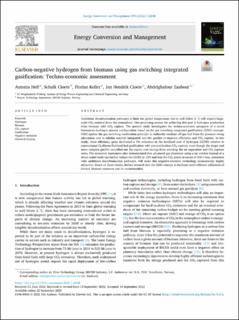| dc.contributor.author | Helf, Antonia | |
| dc.contributor.author | Cloete, Schalk Willem Petrus | |
| dc.contributor.author | Keller, Florian | |
| dc.contributor.author | Cloete, Jan Hendrik | |
| dc.contributor.author | Zaabout, Abdelghafour | |
| dc.date.accessioned | 2022-10-26T12:51:33Z | |
| dc.date.available | 2022-10-26T12:51:33Z | |
| dc.date.created | 2022-10-15T13:34:56Z | |
| dc.date.issued | 2022 | |
| dc.identifier.citation | Energy Conversion and Management. 2022, 270 1-12. | en_US |
| dc.identifier.issn | 0196-8904 | |
| dc.identifier.uri | https://hdl.handle.net/11250/3028461 | |
| dc.description.abstract | Ambitious decarbonization pathways to limit the global temperature rise to well below 2 °C will require large-scale CO2 removal from the atmosphere. One promising avenue for achieving this goal is hydrogen production from biomass with CO2 capture. The present study investigates the techno-economic prospects of a novel biomass-to-hydrogen process configuration based on the gas switching integrated gasification (GSIG) concept. GSIG applies the gas switching combustion principle to indirectly combust off-gas fuel from the pressure swing adsorption unit in tubular reactors integrated into the gasifier to improve efficiency and CO2 capture. In this study, these efficiency gains facilitated a 5% reduction in the levelized cost of hydrogen (LCOH) relative to conventional O2-blown fluidized bed gasification with pre-combustion CO2 capture, even though the larger and more complex gasifier cancelled out the capital cost savings from avoiding the air separation and CO2 capture units. The economic assessment also demonstrated that advanced gas treatment using a tar cracker instead of a direct water wash can further reduce the LCOH by 12% and that the CO2 prices in excess of 100 €/ton, consistent with ambitious decarbonization pathways, will make this negative-emission technology economically highly attractive. Based on these results, further research into the GSIG concept to facilitate more efficient utilization of limited biomass resources can be recommended. | en_US |
| dc.language.iso | eng | en_US |
| dc.publisher | Elsevier | en_US |
| dc.rights | Navngivelse 4.0 Internasjonal | * |
| dc.rights.uri | http://creativecommons.org/licenses/by/4.0/deed.no | * |
| dc.subject | Chemical looping | en_US |
| dc.subject | Negative emissions | en_US |
| dc.subject | Gasification | en_US |
| dc.subject | CO2 capture | en_US |
| dc.subject | Biomass | en_US |
| dc.subject | Hydrogen | en_US |
| dc.title | Carbon-negative hydrogen from biomass using gas switching integrated gasification: Techno-economic assessment | en_US |
| dc.title.alternative | Carbon-negative hydrogen from biomass using gas switching integrated gasification: Techno-economic assessment | en_US |
| dc.type | Peer reviewed | en_US |
| dc.type | Journal article | en_US |
| dc.description.version | publishedVersion | en_US |
| dc.rights.holder | © 2022 The Authors. Published by Elsevier Ltd | en_US |
| dc.source.pagenumber | 1-12 | en_US |
| dc.source.volume | 270 | en_US |
| dc.source.journal | Energy Conversion and Management | en_US |
| dc.identifier.doi | 10.1016/j.enconman.2022.116248 | |
| dc.identifier.cristin | 2061633 | |
| cristin.ispublished | true | |
| cristin.fulltext | original | |
| cristin.qualitycode | 1 | |

